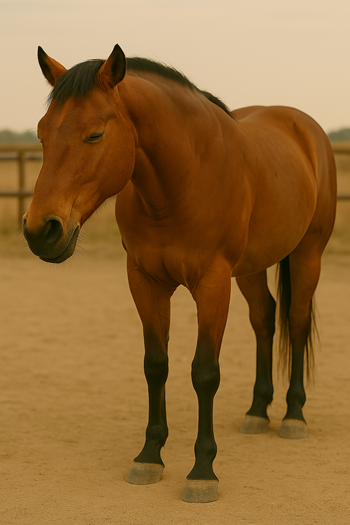
It might be nice to doze off while waiting in the checkout line at the grocery store, but unlike horses, humans cannot sleep standing up. Having evolved to flee in an instant, horses are equipped with a “stay apparatus” that allows them to remain upright for long periods of time. But this mechanism isn’t foolproof and sometimes it causes more harm than good. Although horses may look like they are in a deep sleep while standing they really are just resting. To truly fall asleep, horses need to lie down either on their sternum (breastbone) or their side. This is because to go into REM (Rapid Eye Movement) sleep and dream, our equine friends must have relaxed muscles, which cannot happen when they are standing.
Experts don’t know how or when horses learn that they can activate their stay apparatus. Maybe mares explain this to their foals at birth, or perhaps young horses just figure it out on their own. While the idea of a human popping their kneecap out of place to rest standing sounds painful, it certainly does not seem to bother horses. To maintain a standing position in the hind limb horses must prevent flexing of the stifle, maintain extension of the hock, and prevent overextension of the digital joints. In short, there are several steps that happen at once to allow a horse’s hind limb to lock, and it all starts with lifting the patella (kneecap) over a bony ridge on the end of the femur (thigh bone). By activating the stay apparatus in one hind leg, that leg can bear the brunt of the hindquarter weight, allowing the horse to rest the opposite leg with just the tip of the hoof resting on the ground.
But this mechanism, which, in most cases, is a normal activity for horses, can become a problem. Upward fixation or in layman’s term, a “locking patella,” can be seen in horses who accidentally lock their patella into place. This happens particularly in ponies, where they can pathologically lock both stifles at the same time and are unable to move. An article in the Journal of the American Veterinary Medical Association highlighted an interesting phenomenon that equine surgeons have noticed. In some horses recovering after orthopedic surgery, upward fixation of the patella spontaneously develops. The most recent article involved a horse receiving post-operative morphine, with no previous history of upward fixation until after surgery. Once the morphine was discontinued, the horse’s patellas unlocked.
Horses that have accidentally locked their patella in place and cannot undo it will present with an immovable extended hind limb. If the problem is less severe, the locking may come and go, and riders may notice subtle signs such as a bouncy canter or lead changes. If you have questions about your horse’s stay apparatus or are concerned that upward fixation of the patella may be occurring, contact your local veterinarian.
Provided by the University of Illinois College of Veterinary Medicine, Office of Public Engagement.
Related Articles & Free Email Newsletter Sign Up
Developing Confidence is What Makes Horses Trainable
How to Stop a Horse from Pulling Ahead While Being Lead
How to Teach a Horse to Pull Objects




Comment here